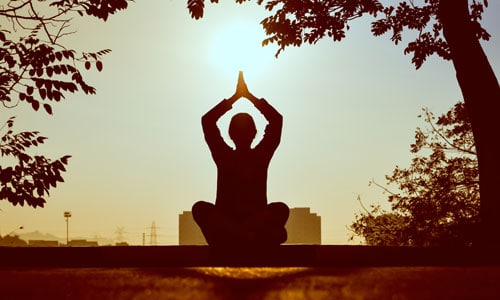Fraser from the Private Therapy Clinic is back again and today he’ll be discussing a very interesting and trendy topic – meditation. In this video, he’ll be discussing what meditation is all about as well as its benefits. He’ll also talk about how meditation can help improve patient well-being by managing stress, anxiety, moods and even behaviour, and how its practice in various industries and even in schools can help a lot of people.
Video Transcript
Hey, guys, this week at Private Therapy Clinic, I’m going to be taking you through a very short and basic introduction to meditation and actually, a lot about the script into a meditation practice session.
We’ll be taking a look at what meditation is actually all about, what it includes, the benefits of meditation, and I’m going to run through that very short script or that very short meditation session. So the first question to ask is what is meditation actually all about? Well, it’s basically to elicit a state of calm or focus or distressing in our minds and our bodies.
Mindfulness is the most commonly used process of meditation right now in society and it’s getting quite a bit attraction and for good reason. Now, when actually utilising meditation, somebody may focus their concentration or the cognitive functioning on an object or actually trying to clear their mind entirely. They may also focus in on their breathing patterns and actually what they’re doing with their breathing and actually focusing in on their breathing can be a huge part of that meditation that they undertake.
So what exactly are the benefits of meditation? Well, the first thing to say is that meditation itself actually has massive benefits in many different ways for our lives. The first point is that it can actually make you much happier. Research is showing time and time again, the meditation can actually assist in the flow of positive thoughts and even positive outcomes in people’s lives. It can also increase positive emotions not only when you’re meditating but actually afterwards as well if it’s a consistent pattern. If you’re meditating on a consistent basis, then those positive emotions and those positive thoughts can sustain you in the long term. It can help manage anxiety, stress, low moods and even behaviour among school kids.
More and more organisations are utilising meditative practices to help with their employees’ production and actually help manage their stress to some degree. Doctors are recommending meditative practices more and more to help alleviate depression or help improve depression rather. And one of the things I think is most compelling with the argument for the positive implications of meditation is that some schools are seeing huge improvements in behavioural issues in school kids. When they utilise meditation rather than giving detention, what’s happening is that meditative practices are being put into schools more and more, and they’re seeing improvements in grades in some schools from some young people so improvements in behaviour from many young people.
I think there’s also something to be said here about the fact that results can actually be seen really, really quickly from meditation. Research has shown that you don’t have to be meditating for a huge amount of time every day for hours and hours on and to gain any benefit. In fact, that same research is showing that just meditating once can elicit massive positive implications for our cognitive and emotional states. The positive implications can be pretty much immediate. Just taking a couple of minutes a day each day can have huge implications for the rest of your day. If you just take those couple of minutes to actually follow bit of a structured meditation practice, you can see massive implications.
Okay, so let’s get into our short and meditation structure. I’m basically going to run you through a very basic and very short introduction to what a meditation session might be like. Now, this is something that you can do on your own. You don’t need to follow me through for this. You can listen to what I’m saying and then maybe take it on yourself. Now, for the purposes of this video, it’s going to be a little bit different because obviously, I’m not going to take a huge amount of time for pausing or for letting people catch up and things like that so this is something that maybe you can pause and play the video again or you can revisit the video and see what you’ve maybe missed some things in your own meditative practices. I really do encourage you to consider these points. Maybe you want to listen to this video enough in full and then take on those points and actually conduct the meditative practice yourself over the course of maybe 10 minutes for example.
Okay, so like I said, we’re going to go through a full relaxation program thatI’m going to run you through just now. So the first thing I’d like you to do is to close your eyes, and try and empty your mind as much as you can. And as you close your eyes, just imagine each thought leaving your mind. Allow yourself to become as present as you possibly can be. You might be sitting though and if you are, just allow your body to feel the position of where you’re sitting. Allow yourself to only really become aware of that sitting position, allowing each intrusive thought just to leave the mind as you’ve got your eyes closed.
Now, when you’re sitting in the most comfortable position it can be in, I want you start to focus a bit of your energy on relaxing each muscle in your body. Now, if we do this through a progressive muscle relaxation technique, then I ask you to start from the very bottom of your feet and we’re going to work our way up all the way through to the top of our heads.
So remaining in that sitting position with our eyes closed, focusing only on that muscle relaxation of the body, we focus on our feet first. Maybe there’s any tension there. Maybe there’s some tension being stored there. Just bring all your focus to your feet. You might want to flex your feet and then relax and allow all that tension to dissipate. We’re then going to bring muscle relaxation focus up through our legs. There may be any tension there then we can unload that to just disappear. Sometimes, it can be helpful to flex some of the muscles and then relax them, just focusing all of our attention on our legs, allowing all tension to be released. I’m ensuring that our eyes are still closed.
We’re going to bring our focus to our backs and our abs. Now, of course, this is somewhere where we can hold a lot of tensions so just notice any tension that is there. Allow yourself to fully relax in your back and your abdomen.You may be conscious of your breathing. Just allow your breathing to relax through your stomach as your stomach inflates and deflates.
We’re then going to bring that attention up to our chests and our shoulders. Again, in an area that there can be a lot of tension, just allow your shoulders to fully relax in the back of your chair, bringing all attention to our neck and torso area.
So next, what we’re going to do is we’re going to bring our attention to our arms. Just ensure that your arms are in a position that feels most comfortable. You may even want to let your arms hang by the side of your chair or just place them by your side. Again, notice any tension in the arms and unload that tension to just be released.
Next, we’re going to bring our attention to our necks and our head. Now, of course, we can lay our head, lay back in our chair and just allow the tension to be released from an area of the body where there can be a massive amount of tension. Take a bit of time here to notice any straining of muscles that there may be. Acknowledge it. Relax that muscle and let the tension leave that area of the body.
Okay, so now that we’ve worked from the bottom of our feet up to the top of our heads, just do a few body checking. Bring only your attention to your body in this moment. Maintain in that sitting position with your eyes closed and just notice then acknowledge the relaxation, the physical relaxation that you’re experiencing. Really allow your body to sink into your chair. And if there are any areas of the body we’re still above tension, just bring your attention to that area. Acknowledge it, and let that tension leave, again bringing your focus back to the body as a whole.
Now that we focused on that physical relaxation process, we’re going to stay in that sitting position, keep your eyes closed and as you have your eyes closed, we’re going to now bring our attention to breathing. We’re going to utilise a couple of exercises here so just acknowledge the breathing. Allow it to relax as fully as we can. We’re going to do something here called belly breathing. When you inhale to the top of your breath, let your stomach expand and as you exhale, allow your stomach to deflate, maintaining that relaxed feeling.
I just want you to do that for a few breaths just now, then a long deep inhale through the nose allowing that stomach to inflate and exhaling through the mouth as it deflates. And for the remainder of the relaxation process, we’re going to maintain that breathing exercise through the belly. What I’d like for you to do now is coupled with that belly breathing is when you inhale a breath, just envision your breath coming through the top of your feet and at the end of inhaling, leaving out through the top of your head. And as you exhale, allow that breath to come to the top of your head and leave at the bottom to feet at the bottom of the breath.
Bringing some imagery into this relaxation process can be really helpful so just allow this technique to settle in just about maintaining that belly breathing.
Now that you’ve done that for a few breaths, we’re going to continue with that breathing regime. So have our eyes closed, just go sit at a nice seating position. Notice the relaxation of the body in the physical sense, and notice the relaxation brought to you through those breathing techniques.
We’re now going to focus in on emptying our minds as much as possible. And what I’d like for you to do here is not so much focused on emptying your minds to nothing but more focusing on your presence in this moment. Allow intrusive thoughts to be recognised but let them pass. Bring your attention in your thinking process to where your body is sitting to that breathing pattern, allowing yourself to be fully relaxed. Just maintain this process till you feel that full state of relaxation.
As we’ve gone through that process to some degree, it’s not bringing your attention more to the present moment, allowing your eyes to open. Recognise your surroundings. Become a little bit more aware of where you are as we start to come towards the end of this relaxation process.
Now, this is a structure that you can repeat time and time again. It’s something that can be really helpful to practice actually in comeback up to a regular basis. Don’t forget, guys, that mindfulness and meditative practices are something that we offer here at Private Therapy Clinic. If it’s something that you’re interested in that you think you could gain more from, then make sure to get in touch with us and we’ll same post you to one of our qualified therapists. And again, thanks so much for watching.
WHO CAN I SPEAK TO FURTHER ABOUT THE ISSUES IN THIS ARTICLE?
For help with the issues discussed in this article speak to one of our therapists here at Private Therapy Clinic for a free initial chat or to make an appointment.
















